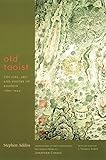Old Taoist : The Life, Art, and Poetry of Kodojin (1865-1944) / Stephen Addiss, Jonathan Chaves, J. Thomas Rimer.
Material type: TextPublisher: New York, NY : Columbia University Press, [2000]Copyright date: ©2000Description: 1 online resource (208 p.) : 25 halftones, 8 color platesContent type:
TextPublisher: New York, NY : Columbia University Press, [2000]Copyright date: ©2000Description: 1 online resource (208 p.) : 25 halftones, 8 color platesContent type: - 9780231116572
- 9780231504003
- PL806.K75Z53 2000
- online - DeGruyter
- Issued also in print.
| Item type | Current library | Call number | URL | Status | Notes | Barcode | |
|---|---|---|---|---|---|---|---|
 eBook
eBook
|
Biblioteca "Angelicum" Pont. Univ. S.Tommaso d'Aquino Nuvola online | online - DeGruyter (Browse shelf(Opens below)) | Online access | Not for loan (Accesso limitato) | Accesso per gli utenti autorizzati / Access for authorized users | (dgr)9780231504003 |
Browsing Biblioteca "Angelicum" Pont. Univ. S.Tommaso d'Aquino shelves, Shelving location: Nuvola online Close shelf browser (Hides shelf browser)

|

|

|

|

|

|

|
||
| online - DeGruyter Catechizing Culture : Missionaries, Aymara, and the "New Evangelization" / | online - DeGruyter The Future of Organized Labor in American Politics / | online - DeGruyter Randall Jarrell on W. H. Auden / | online - DeGruyter Old Taoist : The Life, Art, and Poetry of Kodojin (1865-1944) / | online - DeGruyter River of Fire and Other Stories / | online - DeGruyter Class Act : The Jazz Life of Choreographer Cholly Atkins / | online - DeGruyter The Formation of the Chinese Communist Party / |
Frontmatter -- Contents -- Preface and Acknowledgments -- 1. Kodōjin's Life and Art -- 2. Kodōjin's Japanese Poetry -- 3 Kodōjin and the T'ao Ch'ien. Tradition in Kanshi Poetry -- 4. Kodōjin's Chinese Poetry -- A. Note on Kodōjin and the Art and Literature of His Period -- Epilogue -- Notes -- Index
restricted access online access with authorization star
http://purl.org/coar/access_right/c_16ec
In the literary and artistic milieu of early modern Japan the Chinese and Japanese arts flourished side by side. Kodojin, the "Old Taoist" (1865-1944), was the last of these great poet-painters in Japan. Under the support of various patrons, he composed a number of Taoist-influenced Chinese and Japanese poems and did lively and delightful ink paintings, continuing the tradition of the poet-sage who devotes himself to study of the ancients, lives quietly and modestly, and creates art primarily for himself and his friends.Portraying this last representative of a tradition of gentle and refined artistry in the midst of a society that valued economic growth and national achievement above all, this beautifully illustrated book brings together 150 of Kodojin's Chinese poems (introduced and translated by Jonathan Chaves), more than 100 of his haiku and tanka (introduced and translated by Stephen Addiss), and many examples of his calligraphy and ink paintings. Addiss's in-depth introduction details the importance of the poet-painter tradition, outlines the life of Kodojin, and offers a critical appraisal of his work, while J. Thomas Rimer's essay puts the literary work of the Old Taoist in context.
Issued also in print.
Mode of access: Internet via World Wide Web.
In English.
Description based on online resource; title from PDF title page (publisher's Web site, viewed 02. Mrz 2022)


